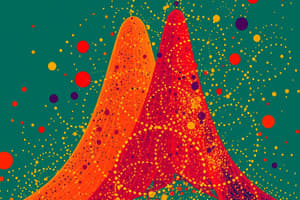Podcast
Questions and Answers
Which distribution is used to model the frequency of rare events?
Which distribution is used to model the frequency of rare events?
- Uniform Distribution
- Binomial Distribution
- Poisson Distribution (correct)
- Normal Distribution
What visual representations can be used to show probabilities in practical applications?
What visual representations can be used to show probabilities in practical applications?
- Pie charts
- Histograms (correct)
- Bar graphs
- Scatter plots
Which distribution is commonly known as the bell curve?
Which distribution is commonly known as the bell curve?
- Poisson Distribution
- Uniform Distribution
- Normal Distribution (correct)
- Exponential Distribution
What does probability theory help us with in practical scenarios?
What does probability theory help us with in practical scenarios?
Are probability theories perfect predictions?
Are probability theories perfect predictions?
Flashcards are hidden until you start studying
Study Notes
Probability is a fundamental concept in mathematics and science used to quantify uncertainty and predict outcomes of uncertain events. It is commonly encountered when dealing with statistical data or making decisions based on chance. The word probability comes from the Latin probabilitas, meaning "approvability," "likelihood," or "chance". In essence, probability tells us how likely it is that something will happen under certain conditions.
Probability is defined as the ratio of favorable outcomes to total possible outcomes. For example, if there are two possible outcomes - "head" and "tail" - and we toss a fair coin, each outcome has a probability of 0.5 or 50% of occurring. This definition works well for discrete events like flipping a coin or rolling dice, where we can count both favorable outcomes and total possibilities. However, things get more complex when we're talking about continuous events like measuring weight or time, which are characterized by infinite possibilities within a range of values.
There are several types of probability distributions that help us understand the distribution of random variables. These include:
- Bernoulli Distribution: A binary variable that has only two possible outcomes and a fixed probability for each outcome. Examples include coin flips and yes/no questions.
- Binomial Distribution: Describes the number of successful trials from a Bernoulli process. Example: Rolling a die multiple times and counting the number of sixes.
- Poisson Distribution: Used to model the frequency of rare events. Examples include arrivals of customers at a store or the number of traffic accidents on a highway.
- Normal Distribution: Also known as bell curve, it describes the distribution of a set of values around its average, called the mean. Most numerical datasets follow this distribution.
Probabilities can also be represented using graphs and charts, such as histograms and probability density functions (PDFs), which give visual representation of the distribution and central tendency of data.
In practical applications, probability theory helps us make informed decisions, assess risks, and optimize processes. For instance, understanding the odds of a disease can guide medical interventions, while predictive models based on historical data can help businesses forecast demand.
However, probability theories are never perfect predictions. They provide expectations and ranges of outcomes rather than exact results. It's essential to remember that probability is inherently uncertain and subject to change given new information or circumstances.
Studying That Suits You
Use AI to generate personalized quizzes and flashcards to suit your learning preferences.




